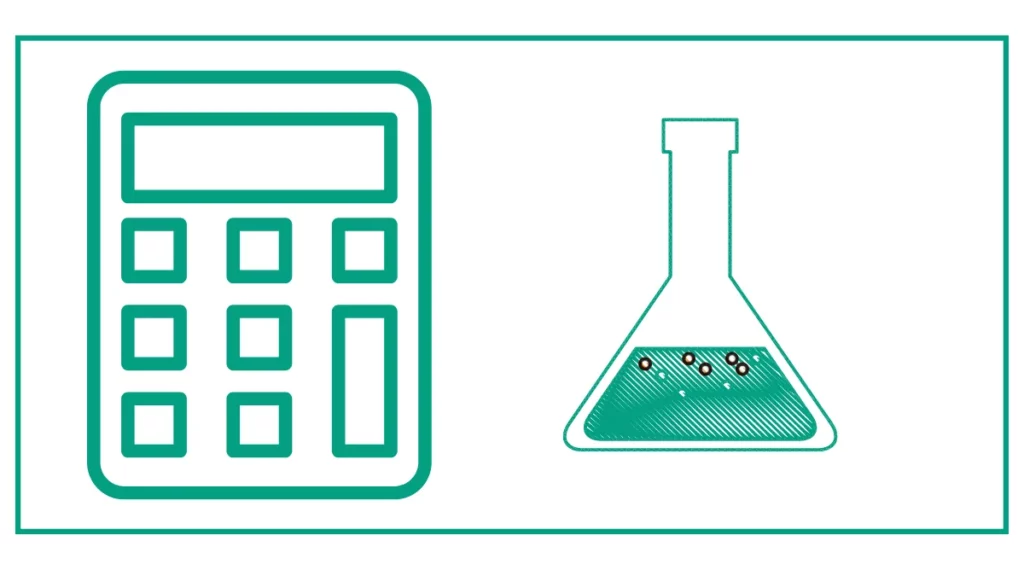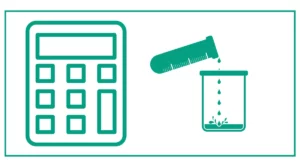Dilution Factor Calculator
The dilution factor calculator helps you calculate the total to-stock dilution factor and dilutant-to-stock dilution factor. It also calculates the final volume.
To determine the dilution factor, enter the initial and final volumes.
In case you don’t know, The dilution factor, commonly known as the dilution ratio, is the solution’s final volume/initial volume ratio.
It reflects the proportion of the stock solution that remains in the total solution.
In chemistry, the dilution factor formula is:
DF = V2 ÷ V1

You might also want to determine the Delta g or Equilibrium constant.
What is Dilution?
Dilution refers to the process of decreasing the concentration of a solution by adding more solvent. When we dilute a solution, we increase its volume while keeping the amount of solute constant. This results in a lower concentration of the solute in the final solution.
The dilution process is often described using the following equation:
C1V1 = C2V2
Where:
- C1 is the initial concentration
- V1 is the initial volume
- C2 is the final concentration
- V2 is the final volume
This equation, known as the dilution equation, is the foundation for understanding and calculating dilutions.
Understanding the Dilution Factor
The dilution factor is a measure of how much a solution has been diluted. It is typically expressed as a ratio of the final volume to the initial volume of the concentrated solution. For example, if 1 ml of a stock solution is diluted to a total volume of 10 ml, the dilution factor is 10.
The dilution factor can be calculated using the following formula:
Dilution Factor = Final Volume / Initial Volume
Alternatively, it may also be expressed as a ratio, such as 1:10, where 1 part of the concentrated solution is mixed with 9 parts of the diluent to achieve a total of 10 parts.
The Importance of Accurate Dilutions
Accurate dilutions are crucial in many scientific and industrial processes. Here are a few reasons why:
- Precision in experiments: Many scientific experiments require specific concentrations of reagents. Inaccurate dilutions can lead to erroneous results.
- Safety: In medical settings, proper dilution of medications is essential for patient safety.
- Quality control: In manufacturing, especially in the food and beverage industry, precise dilutions are necessary to maintain product consistency.
- Cost-effectiveness: Accurate dilutions ensure that expensive reagents or materials are not wasted.
Given the importance of accurate dilutions, tools like the dilution factor calculator have become invaluable in various fields.
How to Use a Dilution Factor Calculator
A dilution factor calculator is a tool that simplifies the process of calculating dilutions. It allows users to input known values and calculates the unknown variables. Here’s a step-by-step guide on how to use a typical dilution factor calculator:
- Identify the known values: Before using the calculator, determine which values you know. This could be the initial concentration, initial volume, final concentration, or final volume.
- Enter the known values: Input the known values into the appropriate fields in the calculator.
- Select the value you want to calculate: Most calculators allow you to choose which variable you want to solve for.
- Click “Calculate”: The calculator will perform the necessary calculations based on the dilution equation.
- Interpret the results: The calculator will provide the value of the unknown variable. Make sure to pay attention to the units of measurement.
Example Calculations Using a Dilution Factor Calculator
Let’s walk through two examples to illustrate how a dilution factor calculator can be used in practical situations.
Example 1: Preparing a Diluted Solution
Suppose you have a stock solution with a concentration of 5 M (molar), and you need to prepare 250 ml of a 0.5 M solution. You want to determine how much of the stock solution you need to use.
Using a dilution factor calculator:
- Enter the initial concentration: 5 M
- Enter the final concentration: 0.5 M
- Enter the final volume: 250 ml
- Select to calculate the initial volume
- Click “Calculate”
The calculator would show that you need 25 ml of the stock solution. You would then add this to enough solvent to make a total volume of 250 ml.
Example 2: Determining the Dilution Factor
Let’s say you have 10 ml of a concentrated solution, and you dilute it to a total volume of 100 ml. You want to know the dilution factor.
Using a dilution factor calculator:
- Enter the initial volume: 10 ml
- Enter the final volume: 100 ml
- Select to calculate the dilution factor
- Click “Calculate”
The calculator would show a dilution factor of 10. This means the solution was diluted by a factor of 10, or we can say it’s a 1:10 dilution.
Advanced Features of Dilution Factor Calculators
Many modern dilution factor calculators offer additional features to enhance their utility:
- Unit conversion: Some calculators allow you to select different volume units (e.g., ml, L, μl) and perform necessary conversions automatically.
- Multiple dilution steps: Advanced calculators can handle serial dilutions, where a solution is diluted multiple times in sequence.
- Concentration units: Calculators may offer options to work with different concentration units, such as molarity, percent weight/volume, or parts per million.
- Reverse calculations: Some tools allow you to input the dilution factor and final volume to calculate the required initial volume.
Common Mistakes
While dilution factor calculators are powerful tools, it’s important to use them correctly to avoid errors. Here are some common mistakes to watch out for:
- Mixing up units: Ensure that all volume units are consistent. If you input the initial volume in ml, the final volume should also be in ml.
- Forgetting to account for the solute volume: In some cases, especially with large dilution factors, the volume of the added solute can significantly affect the final volume.
- Misinterpreting ratios: A 1:10 dilution means 1 part solute to 9 parts diluent, not 1 part solute to 10 parts diluent.
- Overlooking concentration units: Make sure you’re using the same concentration units throughout your calculations.
- Failing to double-check results: Always verify that your calculated results make sense in the context of your experiment or application.
Applications of Dilution Factor Calculators in Various Fields
Dilution factor calculators find applications in numerous scientific and industrial fields:
- Biochemistry and Molecular Biology: Preparing buffers, reagents, and samples for experiments like PCR or protein assays.
- Pharmaceutical Industry: Formulating medications and ensuring proper dosing.
- Environmental Science: Preparing samples for water quality testing or soil analysis.
- Food and Beverage Industry: Adjusting flavors, preparing food additives, or standardizing product concentrations.
- Clinical Laboratory: Diluting patient samples for various diagnostic tests.
- Agriculture: Preparing pesticide or fertilizer solutions for application.

References
- Dilution Factor. (n.d.). California State University. Retrieved July 9, 2023, from csus.edu/indiv/t/toofanj/jthome/students/chem-31/CH31-Subjects/Dilution-FactorXX.pdf





